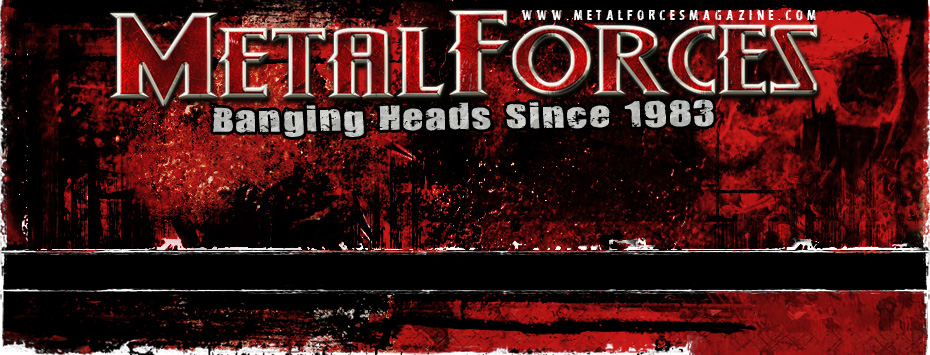
BLIND GUARDIAN – The Tenth Wave
Anthony Morgan
April 2015
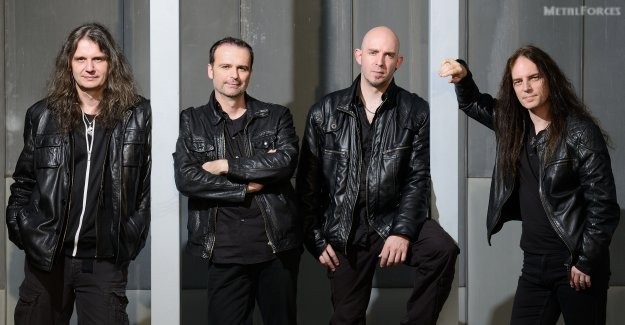 Blind Guardian (l-r): André Olbrich, Hansi Kursch, Frederik Ehmke and Marcus Siepen |
![]()
In penning compositions for January 2015’s Beyond The Red Mirror – their tenth studio full-length overall – German power metal outfit Blind Guardian had no specific goal in mind, despite the fact that the record is a concept affair. Preceding albums were crafted in a similar fashion, the writing process embarking upon its undetermined journey.
“We just start from scratch,” reckons Marcus Siepen, rhythm guitarist for Blind Guardian. “There’s no master plan, or goal, or anything. We just want to make something new. We always want to take the next step. We don’t want to repeat ourselves, so that’s the main goal that we always have whenever we start writing something new. For example, it is a concept album, but that wasn’t the plan in the beginning. That also happened at some point on the way. We just sit down, grab guitars, and start writing and recording new ideas, and see where they lead us.
“We always try to do something different, something that we hadn’t done before – like experiment with a lot of things. For example, on the new album we experimented with down-tuned seven-string guitars, which is something we never did in the past. It obviously changed the sound a bit. It opens up layers in the song for the orchestration. We worked with the orchestra again, and made it even bigger. That’s something that we started on the last album; that was the first time that we could work with a real orchestra, and we loved it. We wanted to explore this further, so that’s what we did on this one. We worked with a couple of big choirs for the first time, because we wanted the choirs to sound really, really huge and big. We just needed a lot of singers for this. We just kept experimenting and playing around with new things, and ended up with hopefully something fresh and new.”
The axeman employment of a seven-string guitar was previously uncharted territory. “I’ve been playing guitars for about 35 years I think, and I’ve never, ever touched a seven-string guitar before in my life,” he divulges. “A friend of mine has one. I looked at it, and it looked weird. That extra string looked scary (laughs). Playing around with those was interesting. It was fun. It was demanding, because you have to constantly concentrate. Otherwise, you just keep hitting the wrong string or hitting the wrong note, and that was actually fun. Playing some of those songs live now, we have seven-string guitars with us. I still have to concentrate. With the six-string stuff, you just grab a guitar. I don’t have to think about what my fingers have to do, because they know where to go. With a seven-string guitar though, it’s something completely different. It keeps my attention very focused at the moment. That might change if it becomes more of a routine playing those guitars, but we’ll see. At the moment, it’s really demanding.”
Perhaps Blind Guardian’s 11th studio outing will feature Marcus handling an eight-string guitar, it is jokingly suggested. “No,” he chuckles. “I think that would be too much for me. A seven-string is okay, but with an eight-string you’re getting into bass guitar territory too much in my opinion. It works for some bands – I know Meshuggah use eight-string, and even nine-string guitars. I’ve got pretty small hands, so I don’t think I could handle a nine-string guitar (laughs). The neck would be too big for me, I guess.”
A conceptual platter, Beyond The Red Mirror continues a narrative established on April 1995 record Imaginations From The Other Side. “Hansi started telling the story on the songs ‘Bright Eyes’, ‘Imaginations From The Other Side’, and ‘And The Story Ends’,” the composer remembers. “Back then, he wrote the story of a kid living in a kind of world which is similar to ours. The kid had the opportunity to step through a kind of portal, to get into a different world where he could be a kind of saviour – an eternal hero – and end an eternal war and stuff like that, but at some point Hansi realised that he had never finished that story.
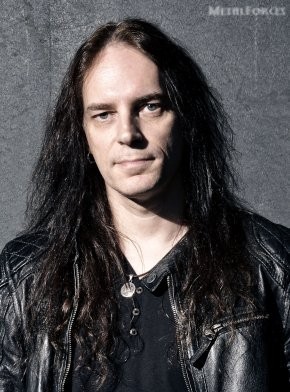
|
“It ends at a point where the kid is at the portal, but we never got to know if the kid took that step, and that’s where we pick up things on the new album. Twenty years have passed, and the kid has grown up. We get to know that he never took that step, because he was just too afraid. After all, he was just a kid, but in those twenty years, the fact that the kid did not go to the other world and fulfil his destiny, it kind of had pretty bad influences on both worlds. This now grown up kid realises this, and starts a kind of journey to look for that final open portal, to finally take that step. That’s the story that’s told on this one.”
Marcus regards Beyond The Red Mirror’s production in high esteem. “Production wise, I think it’s one of the best productions that we’ve ever had because it sounds very warm and natural,” he enthuses. “For me, it’s kind of a natural development. For example, the album has elements that maybe started on the A Night At The Opera album (March 2002). A song like ‘And Then There Was Silence’ was the first time that we did real big orchestration stuff, and so we kind of took it from there. ‘And Then There Was Silence’ was the basis for something like ‘Wheel Of Time’ from the last album, and ‘Wheel Of Time’ was kind of the basis for a song like ‘The Ninth Wave’ for example, or ‘Grand Parade’. For us, it’s a kind of natural development I would say. Each album leads into the next one, and we always try just to take the next step.”
Through the years, Blind Guardian has musically evolved. “I think we’ve changed a lot,” the axe-slinger observes. “We started as a kind of straight speed metal band, a melodic speed metal band. Over the years, we’ve brought a lot of different influences into the music. We obviously became much more complex and much more progressive, but the roots have always been there. That never really changed. We still have very fast, very aggressive stuff and melodies always play a big role for us, but we just like exploring new stuff. If we still sounded like we did on Battalions Of Fear (May 1988), I think we would’ve split up long ago because that would’ve been too boring for us – to play the same stuff over and over again. So yeah, we’ve changed.
“We started as a speed metal band, and then we opened up all of the vocal layers and the guitar layers with albums like Tales From The Twilight World (October 1990) or Somewhere Far Beyond (June 1992). Then we brought more epic stuff into our songs on Imaginations From The Other Side and Nightfall In Middle-Earth (April 1998). The progression came in later, and the big orchestration. What’s gonna happen next, I don’t know. When we start writing new material, which obviously we haven’t started yet, we will look for fresh things and to take the band to the next level hopefully.”
Recording sessions for Beyond The Red Mirror took place at Twilight Hall Studio in Grefrath, Germany with Charlie Bauerfeind, once again. “We’ve worked together for almost twenty years, so he perfectly understands how we see our music, and how we want to do our music,” Marcus feels. “He has the talent to bring out the best in us, and push us beyond our limits in the studio. The working process, we kind of worked in a similar way compared to the last album, which means that we actually started recording once we had finished composing like two or three songs. Then we went into the studio, recorded those three songs, and only after that we continued writing. Then we wrote the next two or three songs, went back to the studio, recorded them, and went back to writing.
“Working like this, it’s more comfortable for us because you get a break from writing or recording. You can clear your head while writing – you don’t have to worry about your performance so much. It’s just about the composition, and in the studio you can just focus on performing. You don’t have to worry about finding new ideas or anything, so it gives you a break from what you did before, and that was very comfortable for us. We just like this way of working, and since we have our own studio which we’ve recorded everything at since Nightfall I think, we can do this. The studio’s available anyway, so we don’t have to worry about working in somebody else’s studio or anything. It gives us freedom to work like that.”
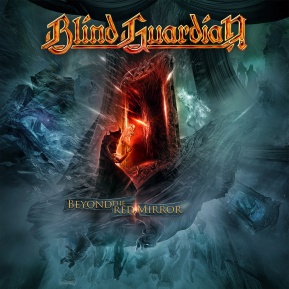
Standard edition artwork 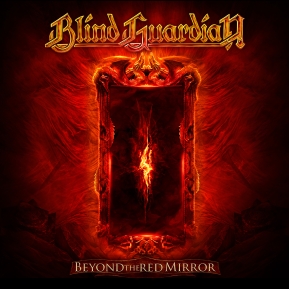
Earbook and digibook edition artwork
|
Cover artwork duties fell to Felipe Machado Franco, once again. “Something we normally do is that we give him our ideas, and he does sketches for us,” the musician discloses. “We talk about them, and tell him ‘Okay, this is great, but can you change it a bit more into whatever direction?,’ or ‘Can you add something in?’ or whatever. Like this, the ideas slowly grow into cover artworks. Actually, we had quite a lot of ideas for this one. We started using different ones; there’s two versions of the album with different covers. You can see lots of other… Not artworks, but images that he did for the whole story in the earbook version of the album. We’re pretty picky about this; we’re as picky about cover artworks as we are about music. It’s a constant exchange of feedback between us and the artist until we think ‘Yeah, that’s it. That’s how we wanted it to look.’”
On April 10th, 2015 at 013 in Tilburg, Netherlands, Blind Guardian began a month-long European trek. Marcus spoke with Metal Forces for this feature on the 12th, the ensemble due to play London, England’s The Forum later that evening. “We hit the road like three days ago, so it’s the third show today in London,” he notes. “We just played Belgium yesterday (Antwerp’s Ho Ter Loo), and the Netherlands on Friday. We did a warm-up show a week ago in our hometown of Krefeld (at Kulturfabrik on the 2nd), and there’s lots of touring ahead of us. So far, all of the shows have been sold out, the audiences have been great. Great vibes, lots of singing and stuff. It’s a lot of fun, so we’re looking forward to the next couple of months.”
Naturally, Blind Guardian’s 2015 setlist boasts material lifted from Beyond The Red Mirror. “At the moment, we’re playing four songs per set,” the axeman informs. “Since it’s not a secret any more, they’re ‘The Ninth Wave’, ‘Twilight Of The Gods’, ‘Prophecies’, and ‘Miracle Machine’ at the moment. There’s another song that we’ve prepared that we just haven’t played yet, because we didn’t want to spoil all of the surprise on the first day (laughs). So, there’s another one from the new album that will be played very soon, and there are some songs that we still want to rehearse once we have a break in the summer. We just have to see how they work out, but yeah. After all, we’re presenting the new album, so we should play some of that stuff.”
Beyond The Red Mirror was released on January 30th, 2015 in Europe (excluding the United Kingdom), on February 2nd in the United Kingdom, and subsequently on the 3rd in North America, all via Nuclear Blast Records.
Interview published in April 2015. All promotional photographs by Hans-Martin Issler.
Related Posts via Categories
- BLIND GUARDIAN – A Voice In The Dark (August 2010) | Features / Interviews @ Metal Forces Magazine
- SCOTTISH SICKNESS – A Report On The Scottish Death Metal Scene, Featuring BRAINBATH, PUTRID FATE And RANCID CADAVER (October 2022) | Features / Interviews @ Metal Forces
- LARVAE – Join The Hardcore Cult! (June 2022) | Features / Interviews @ Metal Forces Magazine
- TRENCH FOOT – Sacrificing Morals For Gory Obscenities (June 2022) | Features / Interviews @ Metal Forces Magazine
- L.A. GUNS – Trigger Happy (March 2019) | Features / Interviews @ Metal Forces Magazine
- CANCER – Crimes So Evil (November 2018) | Features / Interviews @ Metal Forces Magazine
- U.D.O. – The Tank Drives On (August 2018) | Features / Interviews @ Metal Forces Magazine
- SIEGE OF POWER – Bleeding For The Cause (August 2018) | Features / Interviews @ Metal Forces Magazine
- MOONSPELL – A Taste Of Live Eternity (August 2018) | Features / Interviews @ Metal Forces Magazine
- MONSTROSITY – Dark Matter Invocation (August 2018) | Features / Interviews @ Metal Forces Magazine
|
|
